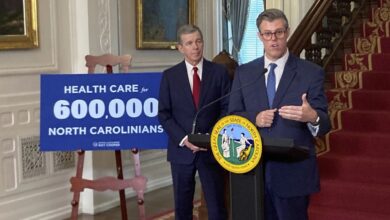
Administrators of upstate New York hospitals want state budget leaders to give rural facilities battling severe staffing shortages more state support as they decide how to spend increased funding in the budget for distressed health centers.
The $237 billion state budget increased Medicaid rates for hospitals and nursing homes and funding for safety net hospitals — or millions of dollars the state will send to distressed facilities. And upstate hospitals want to make sure downstate facilities will not dominate the additional resources.
“We’ve had hospitals, CEOs, that have gone to DOH and tried to get some assistance and because they have too many days’ cash on hand, like 30 instead of five, they’re basically told, ‘We can’t help you,'” Iroquois Healthcare Alliance President & CEO Gary Fitzgerald said Monday. “DOB explained to us in no uncertain terms they’re trying to do the best they can with relatively little amounts of money, so we just want to make sure upstate New York gets its fair share.”
Fitzgerald and other leaders in the Iroquois Healthcare Alliance, including 50 hospital systems from Albany to Rochester, had separate meetings in the last two weeks with state Budget Director Blake Washington and state Health Commissioner James McDonald. Upstate Democratic assemblymembers John McDonald III, Pat Fahy and Carrie Woerner were also in attendance.
The meetings focused on troubling data from the association’s annual financial survey report, which show the vacany rate for registered nurses in its hospitals remains about 18% with high turnover. The vacancy rate is down from about 25% in 2022, but continues to be far above pre-pandemic levels, according to the January analysis.
“Upstate is different than downstate … there’s more people to draw from down there,” Fitzgerald said. “A little bit of money could go a long way in Plattsburgh, Messina and Malone versus down in the city. …We just have to keep reminding them to don’t forget us upstate.”
Officials with the state Budget Division and Health Department confirmed the meetings took place, but declined further comment about the discussion. New York City health officials, labor unions and other organizations have also started petitioning the state departments.
“The FY2025 enacted budget continues New York’s significant investments in the health care system, including providing $3.5 billion to financially distressed hospitals and $1.1 billion over the next three years to implement the 1115 Waiver, which will unlock $5.7 billion in federal funding to address health-related social needs, support safety-net hospitals and address workforce shortages,” Division of the Budget spokesman Tim Ruffinen said in a statement Monday.
Budget officials will work to pay funding allocated in the latest budget to distressed health facilities in the coming months. The state Health Department manages programs that provide supplemental funding to financially distressed hospitals, including the Vital Access Provider Assurance Program.
The majority of upstate hospitals are operating in the negative with total operating margins over -2.6%, according to the alliance survey. Hospital reliance on hiring traveling health staff to meet patient demand has further added to facilities’ fiscal strain.
Regionwide, Iroquois Healthcare Alliance hospitals spent a total of $876 million on traveling staff in 2023 — about $50 million higher than initially estimated. Increased labor costs paired with state staffing requirements in nursing homes have made it increasingly difficult for hospitals to keep beds, or their doors, open.
Michelle LeBeau, president of Champlain Valley Physicians Hospital in Plattsburgh, said the North Country hospital continues to employ about 110 travel staff per day between $75 and $110 per hour, but is short staffed for every level of care.
“There’s a difference between what you aspire to, like what we really want to provide our staff with, and what we’re able to,” said LeBeau, who is also president of the Alice Hyde Medical Center in Malone. “So that becomes a consistent conversation. And sometimes there’s great days and sometimes there aren’t great days. But we talk about it and we continue to sort through it.”
Providers say the state needs a multi-pronged approach to solve upstate’s staffing crisis, including upgraded technology to improve patient care and programs to connect health students to facilities. But in order to do that, they maintain upstate hospitals need more support.
Assemblyman McDonald, a pharmacist from Cohoes, said he’s confident Gov. Kathy Hochul’s administration understands challenges specific to upstate health centers, but the disparity shows the need to change how the Health Department evaluates a hospital’s fiscal strength.
“The thing that’s concerning to me is that traditionally, the approach has been whoever’s running out of money first gets the money, and that’s not what I consider to be the best measurement,” the assemblyman said Monday. “It’s not just about how many days’ cash on hand — it’s about making sure that we’re being very appropriate with how those resources are being allocated to help inspire more people to join the professions, to be part fo the health care system. Because in absence of that, it’s going to lead to detrimental impact on these hospitals, the communities and the people that they serve.”
McDonald is working on a proposal to create a separate bureau within the state Health Department dedicated to measuring hospital finances and other data for a more accurate picture of operations.
Read More



